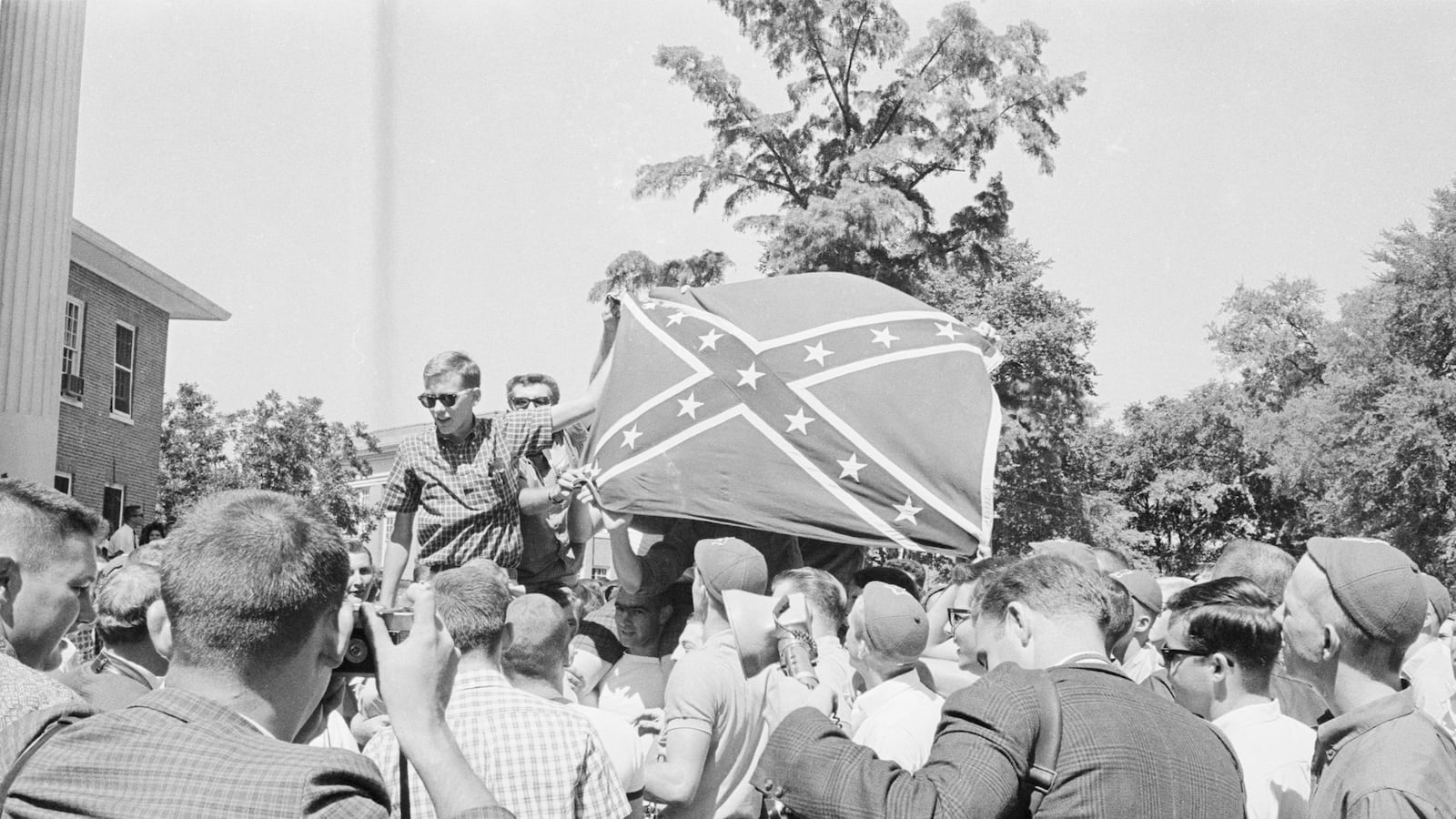There appears to be no sign that the wave of calls to remove Confederate flags from public places, following the murder of nine African-American churchgoers at the AME church in Charleston on June 17, 2015, will crest at any time soon.
This week the University of Mississippi’s Student Senate voted overwhelmingly to remove the state flag, which also includes the Confederate flag design, from its campus. It may come as no surprise that across the South public high schools are debating the place, if any, Confederate flags have on campus. What may come as a surprise, however, is that two schools in New England continue to struggle with an even more deeply rooted connection to Confederate heritage dating back to the 1960s.
An alumnus of Walpole High School in Massachusetts continues to fly a Confederate flag on property adjacent to the school as a sign of his “Rebel” pride. At South Burlington High School in Vermont the school community recently decided to keep its “Rebel” nickname even in response to strong opposition from within the community and the NAACP.
Both high schools embraced Confederate iconography in the 1960s, which witnessed both the Civil War centennial and the Civil Rights struggles. Yearbooks from South Burlington from as early as 1962 featured Civil War soldiers as well as sports teams and other clubs posing under the Confederate flag. The 1964 yearbook included a picturesque mountain scene with a Confederate solider holding a Confederate flag.
In 1968 Walpole turned toward Dixie when it hired John Lee from the University of Memphis to coach its football team. Students soon referred to the team as “General Lee’s Rebels.” Yearbooks from the period suggest that the school community had little difficulty adopting the Confederate banner as a symbol of pride. While Walpole adopted the “Rebel” as its school nickname before the introduction of Lee to its coaching staff, both schools embraced the moniker in connection to the Confederate soldier.
The ease with which these two New England high schools embraced symbols central to the Confederacy points to the strong hold of reconciliation and the Lost Cause on the nation’s collective memory at the beginning of the centennial. Americans hoped to steer clear of the divisive issue of slavery and emancipation in the early 1960s and instead focused on the battlefields on which Americans on both sides fought for their respective causes.
Confederate generals such as Robert E. Lee and Stonewall Jackson loomed large as American heroes as families flocked to battlefields for carefully choreographed reenactments. The emphasis on consensus history at the height of the Cold War, however, could not ignore the growing racial unrest and demands by African-Americans for political equality a hundred years after Abraham Lincoln signed the Emancipation Proclamation.
Interest in the centennial declined by 1963, but whites throughout the South continued to wave Confederate flags, this time as a symbol of “Massive Resistance” against the Civil Rights Movement. Students at Ole Miss appropriated the flag to combat school integration and in former Confederate states like South Carolina, the flag soon flew atop the state house, where it remained until 2000.
The Confederate flag’s connection to resistance to civil rights did not prevent two schools in overwhelmingly white New England communities from embracing it, but neither did their own local connections to the Civil War have any impact.
Both communities answered President Lincoln’s call to put down the rebellion in 1861. Young men went off to war. Some died in battle and others from disease while others returned home with memories that plagued them for the rest of their days. In the years following the war, veterans from Walpole and Burlington joined the rest of their communities to dedicate cemeteries and decorate graves on what was called Decoration Day—what we now call Memorial Day. These cemeteries and monuments attest to the importance the Civil War generation and their children placed on remembering the fallen and on their role in saving the Union and abolishing slavery.
Throughout the 1970s and into the ’80s the Confederate flag enjoyed widespread popularity as it evolved into a popular cultural symbol that retained elements of its controversial past as well as new meanings. Confederate flags could now be purchased with images of outdoor life and even country singers like Hank Williams. The flag was included on all kinds of items from bathing suits to shot glasses and it could be seen at a wide range of political rallies and concert venues.
For the “Rebels” in Walpole and South Burlington the continued presence of the flag and other images reinforced feelings of school pride and identity. As one graduate explained: “I was proud to be a South Burlington Rebel. Our baseball team was undefeated under the Rebel name.”
The first noticeable crack in this Northern “Rebel” line took place in the 1980s when Walpole—with the pressure of an accreditation committee—decided to eliminate the Confederate flag from the school’s sports uniforms. Students continued, however to wave flags at sporting events well into the 1990s. At about this time South Burlington dropped the Confederate Colonel as its official mascot after it was deemed to be inappropriate. These early steps by the two schools did not happen by coincidence, but roughly followed significant shifts in how the Civil War was being taught in the classroom and understood in popular culture.
The success of movies like Glory (1989), Ken Burns’s documentary The Civil War (1990), and more recently, Lincoln (2012), and 12 Years a Slave (2013), highlighted the importance of emancipation and slavery as well as the service and sacrifice of African-Americans in the Union army. More importantly, history textbooks came to place much more emphasis on the history of slavery and its crucial importance during the Civil War era. All of this now makes it much more difficult to divorce the flag from the Confederate government’s goal of creating an independent slaveholding republic.
The release of photographs of Dylann Roof waving a Confederate flag following the Charleston shootings and at a time of increased racial tension has forced Walpole and South Burlington high schools to fully come to terms with their Confederate pasts. In April of this year Walpole removed the “gun-toting” Rebel logo that greeted visitors and students to the school.
Discussions continue about dropping the “Rebel” nickname, but a bigger concern involves an adjacent property that overlooks the school’s athletic complex, which is owned by a graduate of the class of 1969 and who continues to proudly fly a Confederate flag. School administrators recently placed a large banner to block it, but this will likely only serve as a temporary solution.
This week South Burlington’s school board voted unanimously to keep the “Rebel” nickname. During the public forum preceding the vote, one former student shared that she never believed there to be an overt connection to anything political in using the nickname. Meanwhile Chairwoman Elizabeth Fitzgerald argued that a “decision” had been made 20 years ago to cut all ties to the Confederate past. Another student left the meeting in tears.
The president of the local chapter of the NAACP referenced the nickname as “nothing but hate.” School administrators likely are hoping that this issue has been put to rest, but the emotions and views expressed by residents on both sides of the issue in South Burlington and Walpole over the past few months suggest that no decision, regardless of when it is made, can entirely separate the schools from their Confederate past. History is never so easily brushed under the table.
Kevin M. Levin is an educator and independent historian based in Boston. He is currently working with a number of high schools on how best to respond to the controversy surrounding the Confederate flag. Kevin is the author of Remembering the Battle of the Crater: War as Murder (2012) and is currently working on a new book, tentatively titled, Searching For Black Confederate Soldiers: The Origins of Recent Myth. You can find him online at Civil War Memory.






